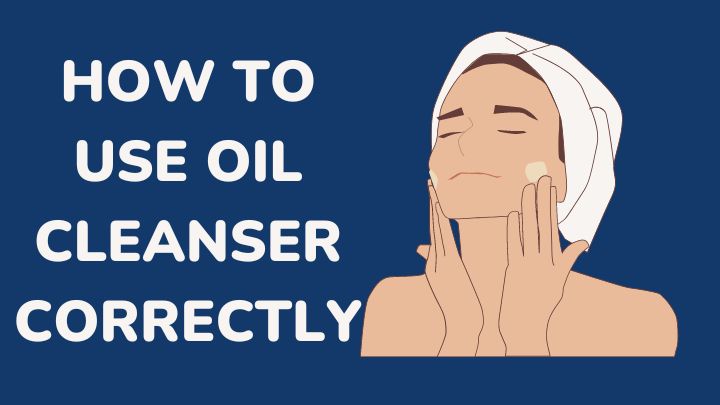Cleansing is a crucial part of any skincare routine- the first, in fact. And there are different types and formulas for every skin type. If you find yourself with an oil cleanser, can you find your way around it when it comes to using it?
Is there a difference with others in application method, you ask? And the answer to this is yes, there is. Oil cleansers are not entirely different from other types of face wash, but they do more than cleansing.
You can read up on oil cleansers and how to use them effectively in this article.
What are oil cleansers?
An oil cleanser is an oil-based facial cleanser used to remove dirt, grime, and makeup residues from the face.
This oil-based product contains light oils like jojoba and other ingredients that emulsify (foam or lather) when applied to the face. This contact with the face slips into the pores to remove residues, thereby clearing the pores.
Additionally, the oil also effectively moisturizes the face as it cleanses, making it the best choice for dehydrated skin.
The oil cleanser formula uses the inference of oil-attracting oil to remove dirt and impurities mixed with sebum on the skin. While it does that, it transfers the moisture from the oil to the face, maintaining clear and supple skin.
It is usually non-comedogenic; it will not clog your pores. Instead, it will hydrate it and keep it supple.
How to use an oil cleanser
1. Apply oil cleanser
This comes first. Apply the oil cleanser of your choice to dry your skin. Working on dry skin than damp skin is better because it allows the cleanser to stick to dirt and grime faster.
While damp skin provides faster lather, oil cleansers are oil-based, so they need to attract oils and dirt without breaking down water.
2. Let it sit
Let the cleanser sit on your face for about two minutes. This gives it enough time to adhere to sebum, dirt, grime, and makeup residue. Do not let it dry on your face; it would push the impurities into your pores instead.
3. Massage oil cleanser on your face
Massage the oil cleanser with open palms, working from the edges of your face inward. Don’t forget to massage your eyelids to remove mascara, eyeliner, and eyeshadow residues. The oil adheres to these residues and removes them with ease.
Also, massage the cheeks to remove dead skin cells lodged on the skin. For dry skin, be sure to work on your cheeks and forehead because they are the driest areas of the face.
4. Rinse off
After massaging all parts of your face, rinse off with water. It’s best to use lukewarm water when oil cleansing. It allows the oil to slip off without moisture slipping out too. Warm water would wash everything off and leave the skin dry again.
5. Dry your face
Use a microfiber towel to dry off your face before you move to the next step of your routine.
How to use oil cleanser in a double cleansing routine
Double cleansing is using two different face washes to remove the oil on your face. The first cleanser is usually an oil cleanser or plain oil, which is used to attract dirt and residues.
Then, it is followed up with a foaming cleanser or micellar water to double cleanse and remove leftover residues on the skin.
To double cleanse:
- Start with your oil cleanser to remove dirt, makeup residues, and excess oil.
- Then, rinse the face with lukewarm water.
- On your damp face, apply a foaming or gentle cleanser.
- Massage the cleanser all over your face.
- Rinse again with lukewarm water.
Note: Foaming or gentle cleansers contain ingredients that would deeply cleanse the pores and leave them hydrated and protected. However, when picking a foaming wash, choose one that does not contain sulfates; they dry up the skin.
How to use oil cleansing balm
Oil cleansing balms are oil cleansers in solid form. They lather when massaged on the skin, then remove impurities and makeup residues.
Oil cleansing balms can be used daily or a few times a week, depending on your skin type and needs. They are particularly beneficial for dry or sensitive skin types, as they provide gentle cleansing without stripping the skin of its natural oils.
You can use oil cleansing balm in the following steps:
- Start by taking a small amount of the oil cleansing balm and rubbing it between your palms to warm it up and melt it.
- Apply the balm to your dry face, massaging it gently in circular motions for about a minute. Make sure to cover all areas of your face, including your forehead, cheeks, nose, chin, and neck.
- Wet a soft washcloth with warm water and wring out the excess water. Use the washcloth to gently wipe away the balm from your face. You may need to repeat this step a few times to remove all the residue.
- Rinse your face with lukewarm water to remove any remaining residue.
- Follow up with your regular cleanser, toner, and moisturizer.
Benefits of using oil cleansers
Deeply cleanses the skin
Oil cleansers are effective in removing makeup, dirt, and impurities from the skin without stripping it of its natural oils. The oil dissolves the impurities, allowing them to be easily wiped away.
Hydrates the skin
Oil cleansers are typically formulated with nourishing oils that hydrate and moisturize the skin, leaving it feeling soft and supple.
Suitable for all skin types
Oil cleansers are suitable for all skin types, including oily and acne-prone skin. Using an oil cleanser can help regulate sebum production, which can reduce the appearance of oily skin.
Non-irritating
Oil cleansers are gentle on the skin and are less likely to cause irritation or inflammation than traditional foaming cleansers.
Removes waterproof makeup
Oil cleansers are particularly effective at removing waterproof makeup, which can be hard to remove with traditional cleansers.
Helps with anti-aging
Oil cleansers can help reduce the appearance of fine lines and wrinkles by keeping the skin hydrated and nourished. Additionally, many oil cleansers contain antioxidants, which can help protect the skin from environmental damage.
FAQs

Are oil cleansers better than foaming cleansers?
No, they are not.
Each type of cleanser caters to specific needs because each individual has different characteristics.
For instance, oil cleansers are known to hydrate the skin. Therefore, they are most suitable for dry and sensitive skin. Meanwhile, foaming cleansers remove excess sebum, which makes them a great option for oily and acne-prone skin.
Your skin type and characteristics will determine what you should go for.
Is micellar water an oil cleanser?
Micellar water is not an oil cleanser.
It only contains molecules that work like oil to remove dirt and impurities on the face while helping retain moisture balance. The water is not oil-based, but it does function like a moisturizing oil.
How often should you use oil cleansers?
Twice a day, every day.
You do not have to be afraid of oil cleansers if you feel they are not perfect for your skin. However, if you will use them, maintain regularity. That is, every day in your morning and night-time routine.
Conclusion
Your skincare routine always starts with cleansing. You can choose to use an oil cleanser because it provides extra moisture to your skin while peeling dirt, residue, and impurities from your skin.
You simply rub it on your face, let it sit, then remove it with a cotton pad or water. You can also make it the first step of your double-cleansing routine.
Moreover, the benefits of oil cleansers include deeply hydrating the skin, keeping your skin blemish-free, and also reduces aging signs. These alone will make you reach for a bottle when shopping next time.
Thanks for reading.
Get more skincare tips here on MBGON.
